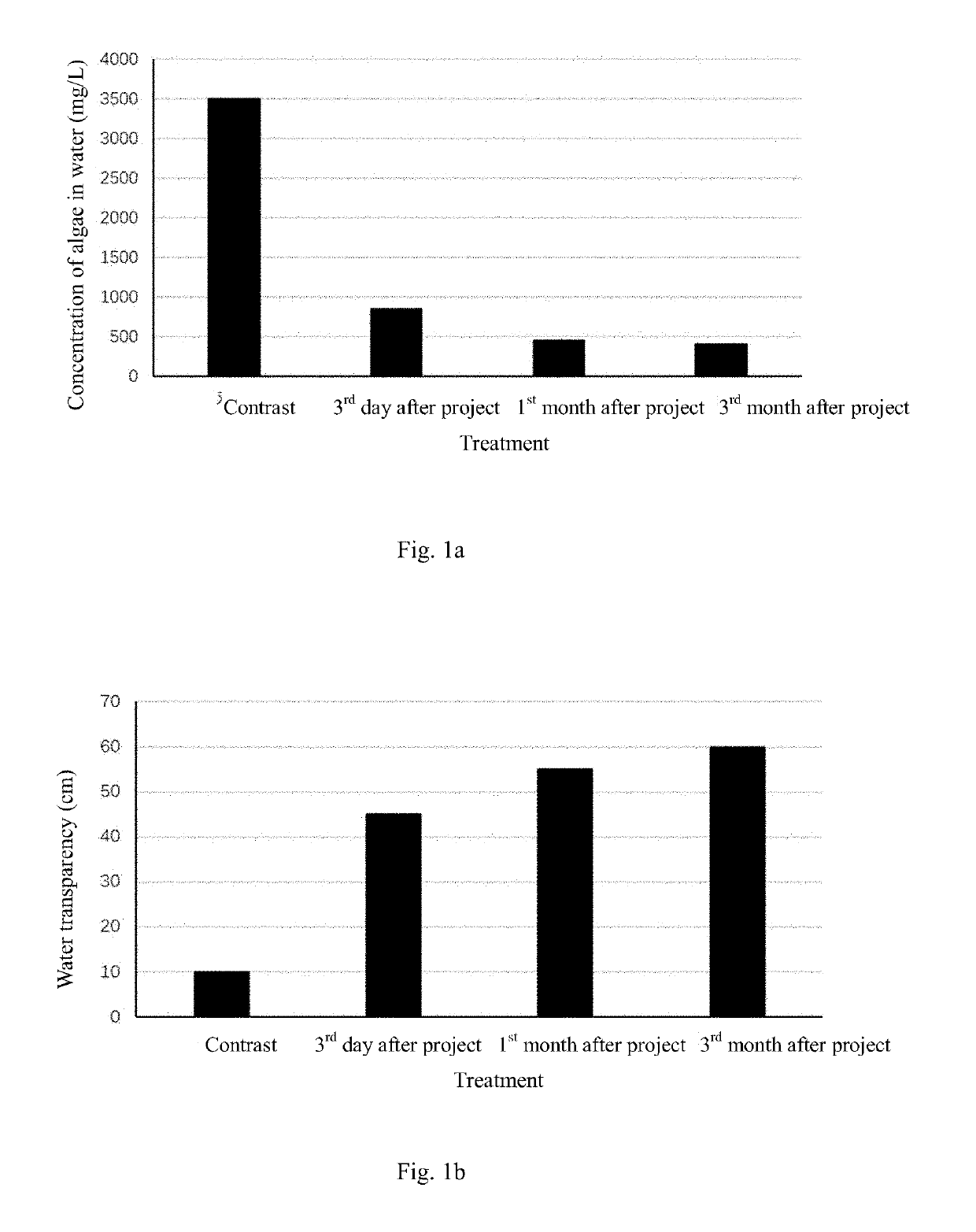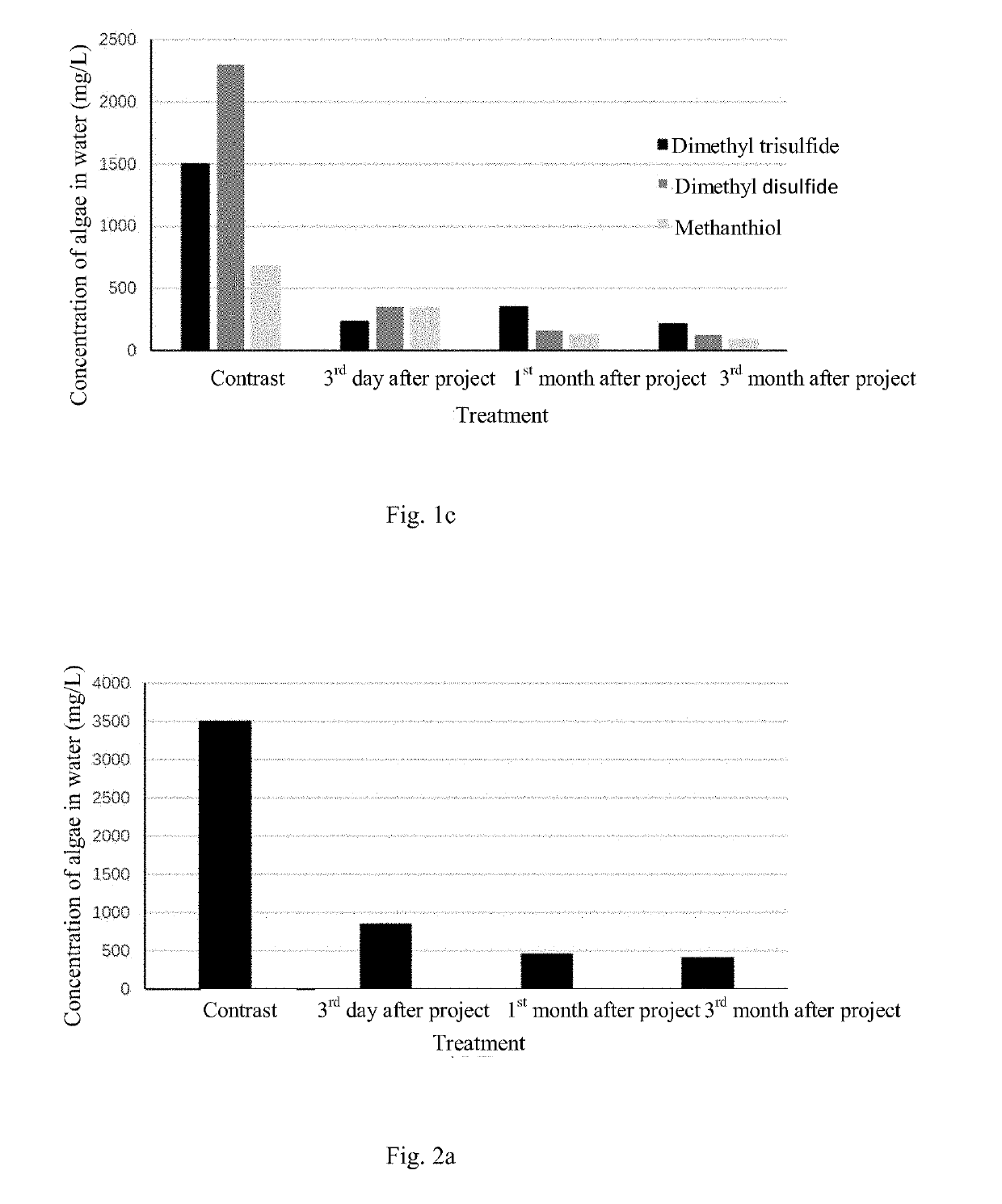Method for in-situ harmless treatment of cyanophycean accumulation and suspended solids in lakeside wetlands
- Summary
- Abstract
- Description
- Claims
- Application Information
AI Technical Summary
Benefits of technology
Problems solved by technology
Method used
Image
Examples
example 1
[0046]Considering that a large amount of accumulated cyanophytes are captured and enriched in eugenic reed wetland plant communities in Gonghu Bay, Taihu Lake, the harmless treatment method of the invention is expected to alleviate severe water ecological problem of water malodor and mass mortality of aquatic organisms due to decay of cyanophycean accumulation in wetlands.
[0047]The embodiment is as follows:
[0048]1) Disposal of flocculation and sedimentation of cyanophycean accumulation in reed wetlands. First, a water sample collected from the wetland cyanophycean accumulation area is analyzed in a laboratory to determine such indicators as algae density, total amount of suspended solids, concentration of substance methyl sulfur-taste odor, dissolved organic carbon and ionic strength in water, so as to preliminarily determine the dosage of diallyl dimethyl ammonium chloride with the degree of substitution of 0.25 and of 20-mesh quartz sand added to cyanophycean flocculation accumula...
example 2
[0052]Considering that a large amount of accumulated cyanophytes are captured and enriched in eugenic reed wetland plant communities in Gonghu Bay, Taihu Lake, the harmless treatment method of the invention is expected to alleviate severe water environment problems of water malodor due to decay of cyanophycean accumulation in wetlands.
[0053]The embodiment is as follows:
[0054]1) Disposal of flocculation and sedimentation of cyanophycean accumulation in reed wetlands. First, a water sample collected from the wetland cyanophycean accumulation area is analyzed in a laboratory to determine such indicators as algae density, total amount of suspended solids, concentration of substance methyl sulfur-taste odor, dissolved organic carbon and ionic strength in water, so as to preliminarily determine the dosage of diallyl dimethyl ammonium chloride with the degree of substitution of 0.60 and of 200-mesh quartz sand added to cyanophycean flocculation accumulated in wetlands. The diallyl dimethyl...
example 3
[0058]Considering that a large amount of accumulated cyanophytes are captured and enriched in eugenic reed wetland plant communities in Paihe River mouth, Caohu Lake, the harmless treatment method of the invention is expected to alleviate severe water environment problems of water malodor due to decay of cyanophycean accumulation in wetlands.
[0059]The embodiment is as follows:
[0060]1) Disposal of flocculation and sedimentation of cyanophycean accumulation in reed wetlands. First, a water sample collected from the wetland cyanophycean accumulation area is analyzed in a laboratory to determine such indicators as algae density, total amount of suspended solids, concentration of substance methyl sulfur-taste odor, dissolved organic carbon and ionic strength in water, so as to preliminarily determine the dosage of diallyl dimethyl ammonium chloride with the degree of substitution of 0.45 and of 80-mesh quartz sand added to cyanophycean flocculation accumulated in wetlands. The diallyl di...
PUM
 Login to View More
Login to View More Abstract
Description
Claims
Application Information
 Login to View More
Login to View More - Generate Ideas
- Intellectual Property
- Life Sciences
- Materials
- Tech Scout
- Unparalleled Data Quality
- Higher Quality Content
- 60% Fewer Hallucinations
Browse by: Latest US Patents, China's latest patents, Technical Efficacy Thesaurus, Application Domain, Technology Topic, Popular Technical Reports.
© 2025 PatSnap. All rights reserved.Legal|Privacy policy|Modern Slavery Act Transparency Statement|Sitemap|About US| Contact US: help@patsnap.com



